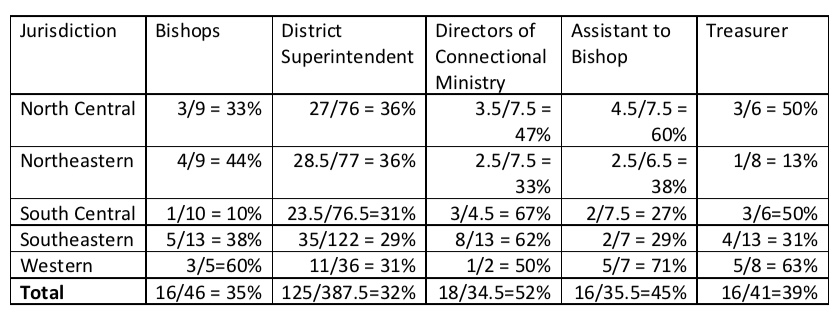In April, 2018, an annual conference desk audit regarding leadership was performed by the General Commission on the Status and Role of Women (GCSRW). During the month of April, we canvassed Annual Conference (AC) websites in the United States to determine who fills leadership positions on the staffs of our United States Annual Conferences.
This method has a few drawbacks: (1) titles for some positions may vary among annual conferences, (2) all positions are not identified on the AC websites (specifically, we could not make definitive claims about deans of cabinets or chancellors), and (3) some Annual Conference websites may not be up-to-date. However, the benefit of not adding additional work to Annual Conference staffs outweighed the drawbacks and we were able to glean some important trends in Annual Conference leadership.
Director of Connectional Ministries
Among Conference leaders, we find the most women appointed as Directors of Connectional Ministry (DCM). A DCM may be lay or clergy and sits with the cabinet “when the cabinet considers matters relating to coordination, implementation, or administration of the conference program, and other matters as the cabinet and director may determine....1 DCMs also have the following responsibilities:
- to serve as steward of the vision of the annual conference, including the development, clarification, interpretation, and embodiment of the vision;
- to serve as leader of the continuous process of transformation and renewal necessary for the annual conference to be faithful to our Christian identity in a changing world;
- to ensure alignment of the total resources of the conference to its vision; and
- to ensure the connections among the local, district, annual conference, and general Church ministries for the purpose of networking, resourcing, and communicating their shared ministry.2
Interestingly, 52% of DCMs are women, the largest percentage of women within a particular Annual Conference leadership category. While DCMs are critical to the work of the Annual Conference, they are not guaranteed a vote in all Cabinet work, except as allowed by a particular bishop.
Assistant to the Bishop
The second largest percentage of women are found in the position of Assistant to the Bishop (45%). In several cases, the same individual serves as both Assistant to the Bishop and DCM. Neither The Book of Discipline nor The Book of Resolutions provides a job description for the Assistant to the Bishop.
Treasurers
Women make up 39% of the Treasurers in the United States Jurisdictions. Annual Conference Treasurers manage the funds of the Annual Conference.3
Bishops and District Superintendents
The remaining two categories of leadership include Bishops, of whom 35% are women, and District Superintendents, of whom 32% are women. These two leadership positions are critical in the church. Frequently, future bishops are elected from the district superintendent pool, so keeping a strong pipeline of district superintendents is critical for the election of new bishops.
Unfortunately, the percentage of women district superintendents has fallen since our last AC Audit in 2016 from 34% to 32%.4 However, it is notable that district superintendents in the Southeast and South Central Jurisdictions are on the rise, from 27% to 29% and 28% to 31%, respectively.5 Unfortunately the North Central, Northeastern, and Western Jurisdictions all dropped in numbers of district superintendents from 39%, 40%, and 47% to 36%, 36%, and 31%, respectively. 6
 Closer examination of trends regarding District Superintendents led us to examine the relationship between female Bishops and the number of District Superintendents in their Annual Conference. This is important because District superintendents are appointed by bishops, not elected. Our comparison showed that women Bishops do not appoint significantly more female District Superintendents.
Closer examination of trends regarding District Superintendents led us to examine the relationship between female Bishops and the number of District Superintendents in their Annual Conference. This is important because District superintendents are appointed by bishops, not elected. Our comparison showed that women Bishops do not appoint significantly more female District Superintendents.

What Does it Mean?
Women continue to comprise about one-third of the leaders in our Annual Conferences. Most of these positions are filled by ordained elders. Statistics show that approximately 27% of clergy (both elders and deacons) in the United States are women. However, we also know that 58% of the membership of the Church is female. Would more women in leadership at the highest levels of the Church encourage other women to explore ordination? Do women in Annual Conference leadership positions encourage other women, and proactively appoint them to leadership positions? What should we consider equitable thresholds for women leaders in the United States Jurisdictions? Is it reasonable to suggest that women and men should share those positions equally?
These are some of the questions we ask ourselves at the General Commission on the Status and Role of Women. Our mandate requires us “to challenge The United Methodist Church...to a continuing commitment to the full and equal responsibility and participation of women in the total life and mission of the Church.”7
1 ¶609.6, The Book of Discipline of The United Methodist Church.
2 Ibid.
3 ¶619, Ibid.
4 WBN, UMC District Superintendents I:Intro and
5 Ibid.
6 Ibid.
7 ¶2102, Book of Discipline
